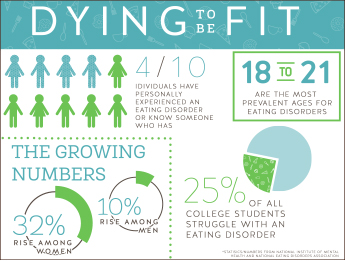Dr. Linda Mintle discusses body image issues plaguing college students
The National Institute of Mental Health estimates that 25 percent of all college students struggle with an eating disorder. This struggle affects people of various ages, but it is most prevalent among 18-21 year olds, according to Dr. Linda Mintle, chair of behavioral health at Liberty’s College of Osteopathic Medicine. Eating disorders also affect both females and males.
Mintle added that this is also the age range in which people struggle with identity issues, one of the core issues involved in the disorders. College is a time when previous eating disorders may worsen, or they can develop for the first time.
College students experience a sense of independence, some for the first time. They are constantly balancing freedom and responsibility. Mintle noted that there are many stressful components of college, which can include friends, romantic relationships and academics. All of these issues can influence the development of an eating disorder.
A 2013 study done by the National Eating Disorders Association (NEDA) shows a 32 percent rise among women and a 10 percent rise among men who are affected by eating disorders. The stresses of college and the pressures students face are increasing in these technological times.
“You look at social media where everybody posts and they want to look perfect,” Mintle said. “They only post the best pictures of themselves, so you do not see what people look like normally. They edit their pictures and control the images. The result is not real life, but a manipulated view of someone’s life.”
“This is also true in advertising and media,” Mintle said. “If you think about how many images you see a day and that those images are not realistic for the most part, it does a number on your thinking.”
Mintle noted that it is not wrong for people to wear makeup or look their best, but culture has become obsessed with physical appearance.
“The best thing you can do is to try not to focus so much on your looks but focus more on the character of people,” Mintle said.
She suggests pointing out positive, non-physical attributes of people, such as their kind heart or their cheery disposition. Friends can also help or they can hurt. A group of strong, encouraging people will lift a person up, but a group of critical peers will only lead to self-esteem problems.
Mintle notes that from a Christian perspective, there is great power in words. She referenced James 3, which talks about the influence of the tongue, both positive
and negative.
She added that the way people think of themselves is often not how God thinks of them.
“God isn’t sitting in heaven thinking ‘Aw man, if she could just lose five more pounds, I could send her on a mission field,’” Mintle said.
In her book “Breaking Free From a Negative Self Image: Finding God’s True Reflection When Your Mirror Lies,” Mintle explains key concepts to change negative thinking and behavior.
“One of the keys is understanding who you are in Christ and developing a very strong God image,” Mintle said.
She noted that people should take care of themselves and their bodies, because their bodies are the temples of the Holy Spirit and were created by God to use for his service.
“There is a balance of looking good, being fashionable and taking care of yourself versus obsessing,” Mintle said. Obsessing over appearance and weight is one of the warning signs that someone may be dealing with an eating disorder.
Mintle shared that other red flags include when people have a hard time loving themselves, sudden vegetarianism, history of depression/anxiety, losing weight, a sudden life event that triggers eating problems, odd eating habits, wearing baggy clothing, refusing to eat in front of others, eating quickly or feeling distressed from eating.
Eating disorders tend to manifest themselves in women through dieting and in men through excessive exercising.
If someone exhibits some of these warning signs, Mintle advised those around them take action.
“The best thing you can do is to speak the truth in love and confront the person, knowing that when you do, the person may deny or get mad at you,” Mintle said. “Later, after they have received help, they will oftentimes come back and be apologetic and appreciative.”
Mintle highlighted that an eating disorder does not usually go away on its own. It is a complicated illness with different layers. Professional help is needed in several areas, on the physical side with help from a medical doctor and dietician, and on the therapeutic side with help from a counselor.
“The earlier you get help, the better the prognosis is,” Mintle said.
According to Mintle, eating disorders are easier to treat before they become habitual, but they can be treated at any stage.
She noted that eating disorders are not something to be taken lightly, especially since they have the highest mortality rate of any psychiatric disorder. Mintle urged students to seek help if they think they may have a problem, to confront friends who show warning signs, to be supportive of those around them and to positively affect the culture.
GLOSSNER is a feature reporter.
